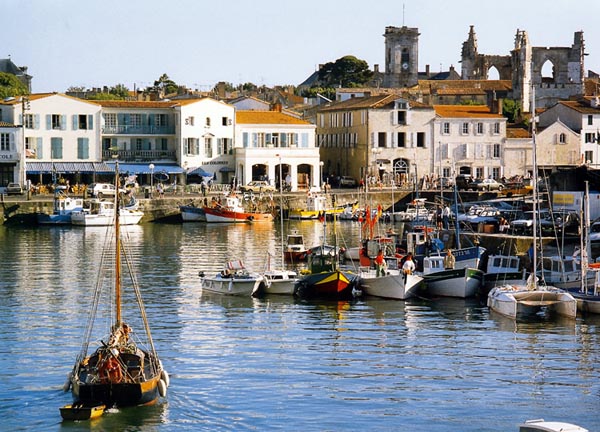
Many years ago I heard about an exclusive French island resort called Île de Ré, which I had assumed was way outside of my price bracket. But I had always wanted to go, so this year, after our major road trip to south west France, we ended up in La Rochelle and realising that this famous island was only 15 miles away we had to take a look.
For hundreds of years Île de Ré was the playground of rich Parisians and then in 1988 they built a bridge which brought this idyll to an end. The bridge opened up the island to everyone and they came in their thousands and still do, mainly to stay in the many camp sites that litter the place. The winter population of 20,000 grows to over 220,000 during the summer and most of them seem to be riding bikes. There are just ten very small villages which are now surrounded by large camp sites. There is still some open country, which is quite flat and not particularly interesting, but the main attractions are the huge sandy beaches.

The main and really the only village worth visiting is St Martin, a beautiful little port with two small harbours; today full of floating gin palaces but nonetheless it has terrific charm. There are lots of lovely little bars and restaurants which, in high summer are packed. The food, mainly from the sea, is terrific and surprisingly not very expensive. St Martin still maintains its exclusive feel; you have to dodge the Ferraris’ and Bentleys that cruise around the narrow streets thronged with the very beautiful people. The many thousands of ordinary tourists that decorate the rest of the island didn’t seem much in evidence in St Martin.

As it was a special occasion we booked a couple of days in one of the two five star hotels on the island, L’Hôtel de Toiras in St Martin. This was the real deal, with just 20 stunning rooms, a beautiful courtyard garden and amazing restaurant. It wasn’t cheap; this is not a hotel for the budget traveller. Set in prime position on the quayside, the hotel is a beautifully restored 17th century merchant’s house. Each bedroom is different and the suites are enormous; views are of the little courtyard garden or the harbour. Decorated in formal townhouse style, it’s a romantic place, more suited to couples than families, all archive wallpapers and antiques. The service is excellent, and double deluxe rooms start from £172. The general manager was the exceptionally personable 34 year-old Pierre Gaillot, who must be the youngest manager of a hotel like this anywhere. The chef, Thierry Bouhier, is certainly deserving of any awards they care to give him, as he produced all the food single-handedly without any staff, and it was fabulous.
The island is quite small, only 30km long and just 5km wide, and despite the thousands of happy campers it still maintains its popularity with the rich and famous. Brad and Angelina and Johnny Depp have been known to hire one of the several secluded villas that are hidden in the woods. The other nine villages left us a little underwhelmed, as they all cater for the mass tourist trade which is, after all, just about the only real industry. After tourism, wine growing is the next most important industry and where there aren’t camp sites there are grape vines. The locals have been producing Fleur de Sel, which is their own sea salt for centuries, and it was salt like we had never tasted.

After our luxurious stay at Hotel Toiras, we moved on to the next little port, La Flotte, where we stayed in the lovely two star hotel, La Galiote, which in many ways was just as nice as the five star luxury just up the road and quite a bit cheaper at €120 (£100). La Flotte is a bit of a one-trick pony; it has a small not particularly attractive harbour, a few quite good restaurants and a pleasant sea front. There is a large apartment/self catering hotel and the island’s other five star hotel is just along the promenade, two extremes about 2km from each other. The food market is perhaps the best on the island; each stall more fascinating than the next, with tarts, fruit, cheese & pâté, plus bread from the excellent bakery.
La Rochelle airport is just 20 minutes by taxi from St Martin, and Ryanair, Flybe, easyJet and Jet2 all fly there from Britain. A cheaper, though longer option is the bus transfer from the airport to the island, which involves a change in La Rochelle. Buses also run between island villages. The 3km bridge that connects Île de Ré to the mainland charges a toll, which was €8 before it doubled in price for the rest of the summer. They only charge one way, so you leave for free.
The main reasons for visiting Île de Ré are for the fantastic beaches, surfing, the Hotel Toiras and dinner in St Martin. The very top of the island is heavily wooded and has some spectacular beaches with very high sand dunes, which are ideal for sun-bathing ‘au naturel’.
After three days we seemed to have driven the few main roads about ten times and were quite happy to say au revoir to Île de Ré.

















You must be logged in to post a comment.